
A kayak is a small, narrow human-powered watercraft typically propelled by means of a long, double-bladed paddle. The word kayak originates from the Greenlandic word qajaq.

Kayaking is the use of a kayak for moving over water. It is distinguished from canoeing by the sitting position of the paddler and the number of blades on the paddle. A kayak is a low-to-the-water, canoe-like boat in which the paddler sits facing forward, legs in front, using a double-bladed paddle to pull front-to-back on one side and then the other in rotation. Most kayaks have closed decks, although sit-on-top and inflatable kayaks are growing in popularity as well.
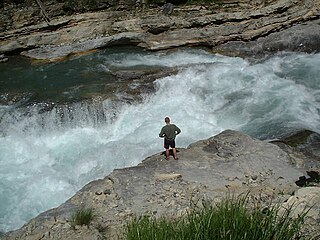
Whitewater forms in the context of rapids, in particular, when a river's gradient changes enough to generate so much turbulence that air is trapped within the water. This forms an unstable current that froths, making the water appear opaque and white.

Whitewater kayaking is an adventure sport where a river is navigated in a decked kayak. Whitewater kayaking includes several styles. River running; where the paddler follows a river and paddles rapids as they travel. Creeking usually involving smaller, steeper, and more technical waterways. Creek boats tend to be short but high volume to allow for manoeuvrability while maintaining buoyancy. Slalom requires paddlers to navigate through "gates". Slalom is the only whitewater event to be in the Olympics. Play boating involves staying on one feature of the river and is more artistic than the others. Squirt boating uses low-volume boats to perform special moves in whitewater features.

Canoe slalom is a competitive sport with the aim to navigate a decked canoe or kayak through a course of hanging downstream or upstream gates on river rapids in the fastest time possible. It is one of the two kayak and canoeing disciplines at the Summer Olympics, and is referred to by the International Olympic Committee (IOC) as Canoe/Kayak Slalom. The other Olympic canoeing discipline is canoe sprint. Wildwater canoeing is a non-Olympic paddlesport.

Canoe freestyle is a discipline of whitewater kayaking or canoeing where people perform various technical moves in one place, as opposed to downriver whitewater canoeing or kayaking where the objective is to travel the length of a section of river. Specialised canoes or kayaks (boats) known as playboats are often used, but any boat can be used for playing. The moves and tricks are often similar to those performed by snowboarders, surfers or skaters, where the athlete completes spins, flips, turns, etc. With modern playboats it is possible to get the kayak and the paddler completely airborne while performing tricks. The competitive side of playboating is known as freestyle kayaking.
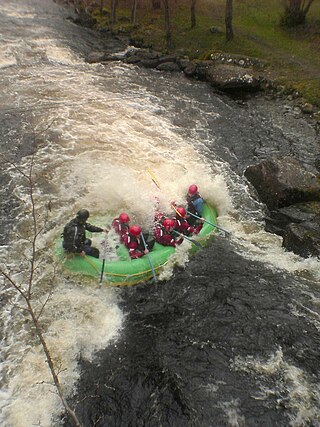
The international scale of river difficulty is an American system used to rate the difficulty of navigating a stretch of river, or a single rapid. The scale was created by the American Whitewater Association to evaluate rivers throughout the world, hence international in the title. It should not be confused with the internationally used whitewater scale, which is published and adapted by a committee of the International Canoe Federation (ICF). The grade reflects the technical difficulty and skill level required associated with the section of river. The scale is of use to various water sports and activities, such as rafting, riverboarding, whitewater canoeing, stand up paddle surfing, and whitewater kayaking.

The U.S. National Whitewater Center (USNWC) is a not-for-profit outdoor recreation and athletic training facility for whitewater rafting, kayaking, canoeing, rock climbing, mountain biking, hiking and ice skating which opened to the public in 2006. The Center is located in Charlotte, North Carolina on approximately 1,300 acres (530 ha) of land adjacent to the Catawba River, with more than 50 miles (80 km) of developed trail.
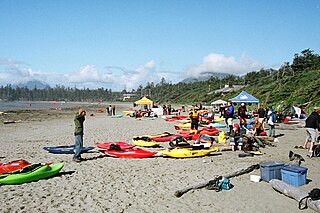
Surf kayaking is the sport, technique, and equipment, used in surfing ocean waves with kayaks. Surf kayaking has many similarities to surf board surfing, but with boats designed for use in surf zones, and with a paddle. A number of kayak designs are used, but all are aimed at better using the waves to propel the craft.
Canoe Wales is the national governing body for paddlesport in Wales. It covers all branches of the sport from recreational canoeing, kayaking, stand up paddleboarding and rafting to whitewater racing, slalom racing and wildwater racing; flatwater sprint racing and marathon racing; canoe sailing; canoe polo; surf kayaking and canoeing; and extreme racing. The organisation has over 2,700 members including individual paddlers as well as affiliated club members. Full adult members of Canoe Wales are also by default Welsh members of British Canoeing.

Creeking is a branch of canoeing and kayaking that involves descending very steep low-volume whitewater. It is usually performed in specialized canoes and kayaks specifically designed to withstand the extreme whitewater environment in which the activity occurs. In addition, the canoes and kayaks give the paddler improved performance and maneuverability needed to avoid river obstacles.
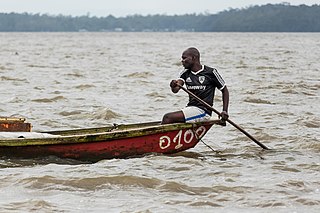
Paddling, in regard to waterborne transport, is the act of propelling a human-powered watercraft using at least one hand-held paddle. The paddle, which consists of one or two blades joined to a shaft, is also used to steer the vessel via generating a difference in propulsion between the two sides of the watercraft. The paddle is not connected to the boat, unlike in rowing where the oar is attached to the boat.

Standup paddleboarding (SUP) is a water sport born from surfing with modern roots in Hawaii. Standup paddleboarders stand on boards that are floating on the water and use a paddle to propel themselves through the water. The sport was documented in a 2013 report that identified it as the outdoor sporting activity with the most first-time participants in the United States that year. Variations include flat water paddling, racing, surfing, whitewater SUP, yoga, and fishing.

Whitewater canoeing is the sport of paddling a canoe on a moving body of water, typically a whitewater river. Whitewater canoeing can range from simple, carefree gently moving water, to demanding, dangerous whitewater. River rapids are graded like ski runs according to the difficulty, danger or severity of the rapid. Whitewater grades range from I or 1 to VI or 6. Grade/Class I can be described as slightly moving water with ripples. Grade/Class VI can be described as severe or almost unrunnable whitewater, such as Niagara Falls.
The Philadelphia Canoe Club (PCC) is one of oldest paddling organizations in the United States. Headquartered in an 18th-century mill at the confluence of the Wissahickon Creek and Schuylkill River in the Manayunk section of Philadelphia, PCC counts among its members more than 200 canoeists and kayakers who take scores of trips every year on local rivers and streams as well as numerous waterways throughout North America.

Canoeing – recreational boating activity or paddle sport in which you kneel or sit facing forward in an open or closed-decked canoe, and propel yourself with a single-bladed paddle, under your own power.

Canoe & Kayak UK was a British canoeing magazine. It was primarily focused on sea, surf and whitewater paddling.
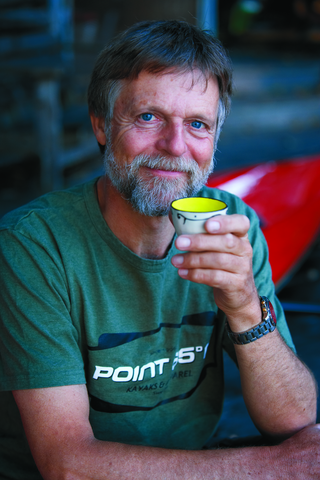
Nigel Foster is an English sea kayaker, kayak designer, instructor and author. He is the first and youngest paddler to circle Iceland by kayak.

Nantahala Township is located in North Carolina, United States in the part of Macon County which is west of Wayah Gap. It has a population of 1,711. "Nantahala" is a Cherokee word which means "The sun between them".
Confluence Outdoor is an American manufacturer of kayaks, canoes, and related accessories. The company comprises seven separate brands which each specialize in paddling sport boats or accessories.















